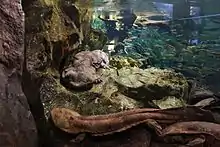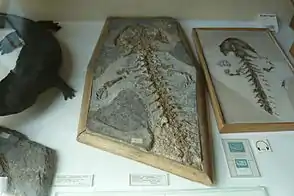Giant salamander
The Cryptobranchidae are a family of fully aquatic salamanders commonly known as the giant salamanders. A single species, the hellbender (Cryptobranchus alleganiensis), inhabits the eastern United States, with species also inhabiting China and Japan. They are the largest living amphibians known today. The Japanese giant salamander (Andrias japonicus) reaches up to 1.44 m (4.7 ft) in length, feeds at night on fish and crustaceans, and has been known to live for more than 50 years in captivity.[1] The South China giant salamander (Andrias sligoi) can reach a length of 1.8 m (5.9 ft).[2]
| Giant salamanders | |
|---|---|
 | |
| Andrias japonicus | |
| Scientific classification | |
| Kingdom: | Animalia |
| Phylum: | Chordata |
| Class: | Amphibia |
| Order: | Urodela |
| Suborder: | Cryptobranchoidea |
| Family: | Cryptobranchidae Fitzinger, 1826 |
| Genera | |
| |
Taxonomy
The family name is from the Ancient Greek krypto ("hidden"), and branch ("gill"), which refer to how the members absorb oxygen through capillaries of their side-frills, which function as gills.
Clade Pancryptobrancha (Cryptobranchidae + Ukrainurus)
- Genus †Ukrainurus
- Genus †Chunerpeton
- Family Cryptobranchidae
- Genus Cryptobranchus (hellbenders)
- †Cryptobranchus saskatchewanensis[3]
- Cryptobranchus alleganiensis (hellbender)
- Genus Andrias (Asian giant salamanders; sometimes classified among the Cryptobranchus)
- Andrias davidianus (Chinese giant salamander) – (Simplified Chinese: 娃娃鱼; pinyin: wáwáyú) (may actually be a species complex of 5 different species)
- Andrias sligoi (South China giant salamander)[4][5]
- Andrias japonicus (Japanese giant salamander) – (Japanese: オオサンショウウオ)
- †Andrias bohemicus
- †Andrias matthewi
- †Andrias scheuchzeri
- Genus †Aviturus
- †Aviturus exsecratus
- Genus †Ulanurus
- †Ulanurus fractus
- Genus †Zaissanurus
- †Zaissanurus beliajevae
- Genus Cryptobranchus (hellbenders)
Fossil record
Extant species in the family Cryptobranchidae are the modern-day members of a lineage that extends back millions of years; the earliest fossil records of a basal species date back to the Middle Jurassic and were found in volcanic deposits in northern China.[6] These specimens are the earliest known relatives of modern salamanders, and together with the numerous other basal groups of salamanders found in the Asian fossil record, they form a firm base of evidence for the fact that "the early diversification of salamanders was well underway" in Asia during the Jurassic period.[6] Little has changed in the morphology of the Cryptobranchidae since the time of these fossils, leaving researchers to note "extant cryptobranchid salamanders can be regarded as living fossils whose structures have remained little changed for over 160 million years."[6]
As the fossil record for the Cryptobranchidae shows an Asian origin for the family, how these salamanders made it to the eastern US has been a point of scientific interest. Research has indicated a dispersal via land bridge, with waves of adaptive radiation seeming to have swept the Americas from north to south.[6][7]
In 1726, the Swiss physician Johann Jakob Scheuchzer described a fossil as Homo diluvii testis (Latin: Evidence of a diluvian human), believing it to be the remains of a human being who drowned in the biblical flood. The Teylers Museum in Haarlem, Netherlands, bought the fossil in 1802, where it is still exhibited. In 1812, the fossil was examined by Georges Cuvier, who recognized that it was not human. After being identified as a salamander, it was renamed Salamandra scheuchzeri by Holl in 1831. The genus Andrias was coined six years later by Tschudi. In doing so, both the genus, Andrias (which means "image of man"), and the specific name, scheuchzeri, ended up honouring Scheuchzer and his beliefs. It and the extant A. davidianus cannot be mutually distinguished, and the latter, only described in 1871, is therefore sometimes considered a synonym of the former.[8]
Description
Cryptobranchids are large salamanders, with large folds of skin along their flanks. These help increase the animals' surface area, allowing them to absorb more oxygen from the water. They have four toes on the fore limbs, and five on the hind limbs. Their metamorphosis from the larval stage is incomplete, so the adults retain gill slits (although they also have lungs), and lack eyelids. They have bad eyesight. They can reach a length of 1.8 m (5.9 ft), though most are considerably smaller today.[2]
Distribution and habitat
In Japan, their natural habitats are threatened by dam-building. Ramps and staircases have been added to some dams to allow them to move upstream to areas where they spawn. [9]
Behavior
A Japanese giant salamander lived for 52 years in captivity.[1]
Feeding
The Chinese giant salamander eats aquatic insects, fish, frogs, crabs, and shrimp.[10] They hunt mainly at night. As they have poor eyesight, they use sensory nodes on their heads and bodies to detect minute changes in water pressure, enabling them to find their prey.[11]
Reproduction
During mating season, the salamanders travel upstream, where the female lays two strings of over 200 eggs each. The male fertilizes the eggs externally by releasing his sperm onto them, and then guards them for at least three months, until they hatch.[10] At this point, the larvae live off their noticeable stored fat until ready to hunt. Once ready, they hunt as a group rather than individually.
Scientists at Hiroshima City Asa Zoological Park in Japan have recently discovered the male salamander will spawn with more than one female in his den. On occasion, the male "den master" will also allow a second male into the den; the reason for this is unclear.
References
- Andrias japonicus. AmphibiaWeb: Information on amphibian biology and conservation. 2012. Berkeley, California: AmphibiaWeb. Retrieved 13 December 2012.
- Andrias davidianus. AmphibiaWeb: Information on amphibian biology and conservation. 2012. Berkeley, California: AmphibiaWeb. Retrieved 13 December 2012.
- "Fossilworks: Cryptobranchus saskatchewanensis". fossilworks.org. Retrieved 30 August 2019.
- "World's largest amphibian identified as a unique species". Animals. 2019-09-16. Retrieved 2019-09-17.
- Turvey, S. T.; Marr, M. M.; Barnes, I.; Brace, S.; Tapley, B.; Murphy, R. W.; Zhao, E.; Cunningham, A. A. (2019). "Historical museum collections clarify the evolutionary history of cryptic species radiation in the world's largest amphibians". Ecology and Evolution. 00 (18): 10070–10084. doi:10.1002/ece3.5257.
- Gao, Ke-Qin; Shubin, Neil H. (27 March 2003). "Earliest known crown-group salamanders". Nature. 422 (6930): 424–428. doi:10.1038/nature01491. PMID 12660782. S2CID 4411650.
- Swanson, P.L. (September 1948). "Notes on the Amphibians of Venango County, Pennsylvania". American Midland Naturalist. 40 (2): 362–371. doi:10.2307/2421606. JSTOR 2421606.
- Frost, Darrel R. (31 January 2011). "Andrias Tschudi". Amphibian Species of the World: An online reference (Version 5.5 ed.). New York, NY: American Museum of Natural History.
"Online access electronic database". New York, NY: American Museum of Natural History. Retrieved 13 December 2012. - "Giant Salamanders Helped to Spawn" 31 December 2009. National Geographic Society. Retrieved 13 December 2012.
- Lanza, B.; Vanni, S. & Nistri, A. (1998). Cogger, H.G. & Zweifel, R.G. (eds.). Encyclopedia of Reptiles and Amphibians. San Diego: Academic Press. p. 69. ISBN 0-12-178560-2.
- Glenn, C.R. (2006). "Chinese Giant Salamander Facts". Earth's Endangered Creatures. Retrieved 13 December 2012.
External links
| Wikimedia Commons has media related to Cryptobranchidae. |


